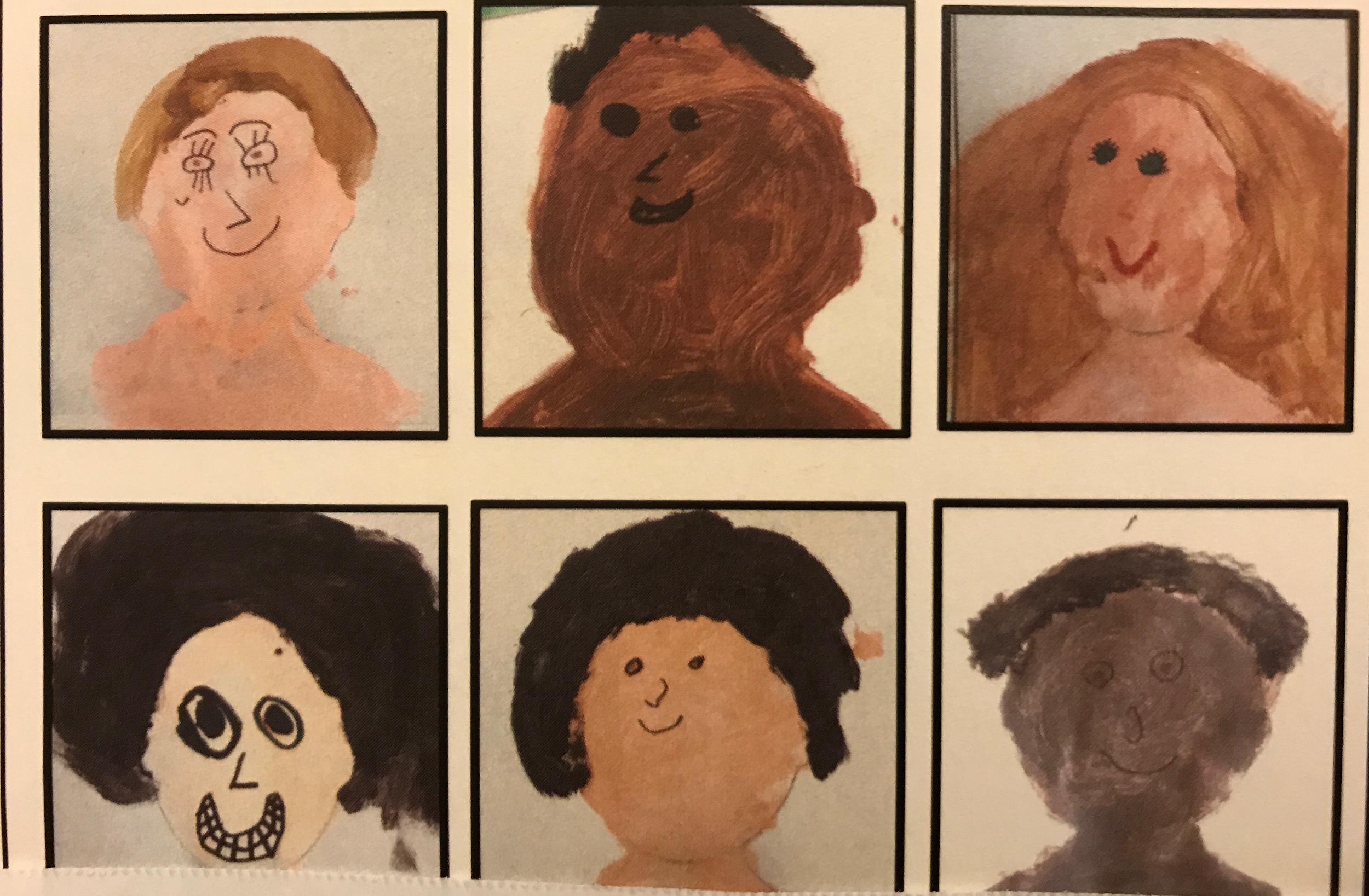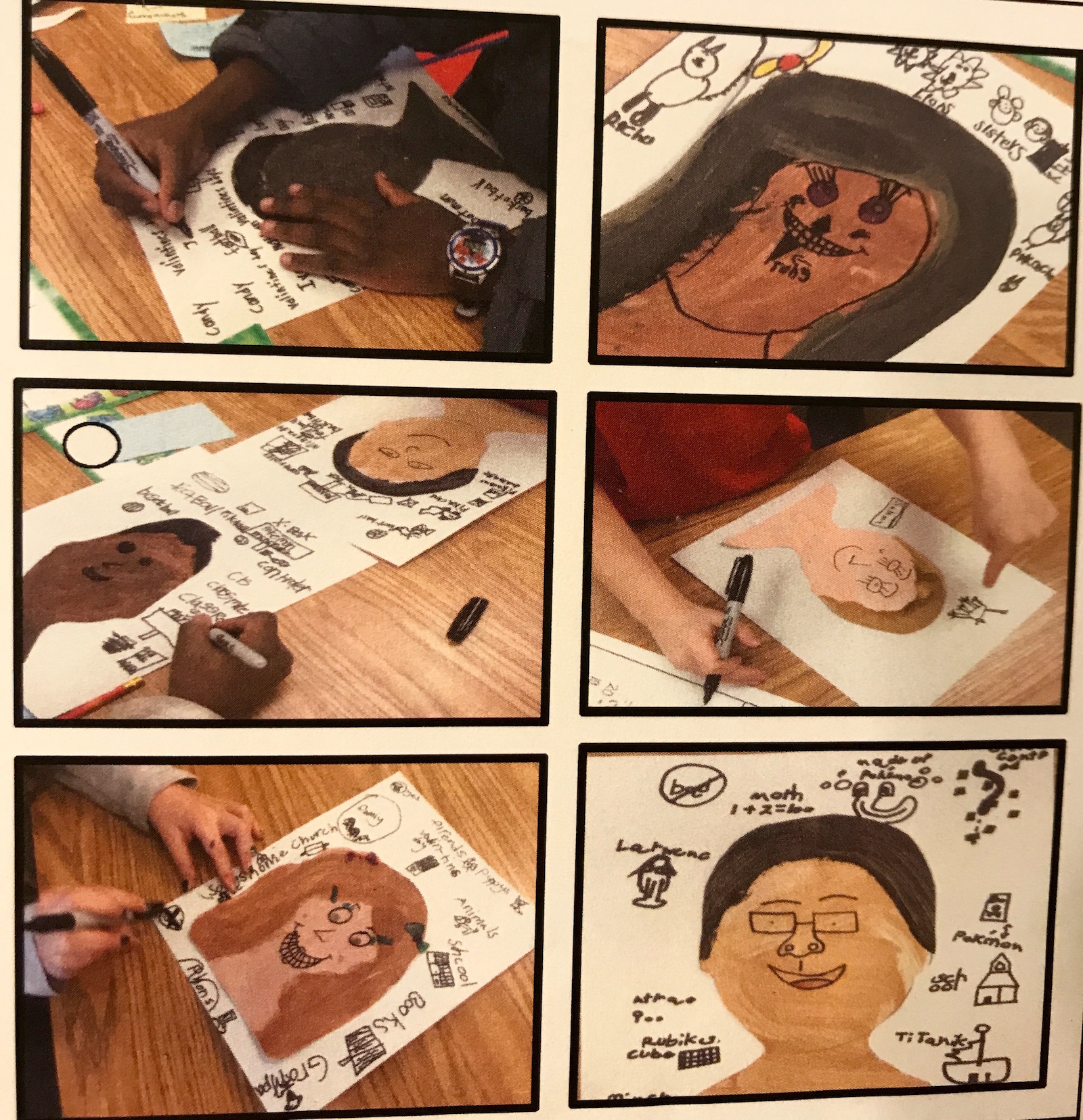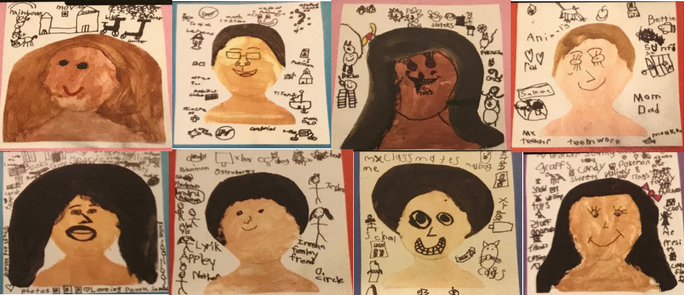Engaging First Graders in an Exploration of Race through Children’s Literature
Kelly Cutler
As an educator, I often hear teachers suggest that young children are not “ready” to tackle controversial topics such as race, racism, and racial identity. Reasons are oftentimes stated, such as “that’s not developmentally appropriate” or “they’re too young to understand that concept.” In direct contrast, the last sixty years of educational research indicates that children do understand the concept of race at a very early age (Clark, 1988; Derman-Sparks & Ramsey, 2011; Goodman 1952; Katz, 2013; Proshansky, 1966). Yet often adults, including parents and educators, do not recognize children’s ability to understand race. Most teachers–particularly White teachers–have difficulty talking to children and educators about race and racism (Copenhaver, 2000; Glazer, 2003; Lewis, 2001; Pollock, 2004; Willis, 2003). As a result, many educators have adopted a color-blind mentality– denying or minimizing the impact of race on an individual’s experiences–believing this is the most effective way to deal with race, racial inequities, and racial diversity in schools (Bakari, 2003; Banks, 2006; Husband, 2012; Milner, 2010; Modica, 2015).
So why does the silence around race in education matter? Although color-blindness might appear positive on the surface, in reality it has negative consequences for students when their racial, ethnic, cultural, and linguistic differences are widely ignored (Hawley & Nieto, 2010; Sleeter, 1996; Tatum, 1992). Further, since the 2016 presidential election, hate violence, as well as incidents of harassment that are racial in nature, are on the rise. The Southern Poverty Law Center (2017) refers to this rise in racially charged events as the “Trump Effect.” According to the Southern Poverty Law Center (2017), 867 hate incidents were reported just in the first 10 days after the election, of which the majority occurred on university campuses or in K-12 schools. Pollock (2008) argues that educators need to talk directly with students about race and racial disparities– specifically causes and solutions– to eliminate disparities altogether.
As a result, I became curious about how elementary students experience lessons on race, racism, and racial identity. Using the children’s books The Colors of Us (Katz, 2002), Shades of People (Rotner, 2009), All the Colors We Are: The Story of How We Get Our Skin Color (Kissinger, 2014), and Skin Again (hooks, 2004), I engaged first-grade students in conversations about defining race, racism, and their own racial identities. The literature was used as an entry point for engaging in the taboo topic of race. Steele and Cohn-Vargas (2013) point out that literature can be a means for providing an entrance for talking about all kinds of differences and creates possibilities for open-ended discussion about race and culture.

Figure 1: Children’s literature used for discussions about race.
Context
The students were first graders attending an elementary school in a large metropolitan area in the western United States. The school demographics were: 39% White, 22% Latina/o, 19% Asian, 11% Black/African American, 7% Multiracial, 2% Native Hawaiian/Pacific Islander, and 1% Native American/Alaska Native. Approximately 73% qualified for free or reduced lunch, 44% received English language services, and 10% were receiving special education services. Fifteen of the 23 first-grade students participated in this project, which took place in their classroom over a period of four days. Although not all participated in the research study, all students did participate in the activities. In this vignette, I will describe how the children’s literature was used and outline the lessons as students experienced them.
What is Race?
Steele and Cohn-Vargas (2013) suggest that the primary role of educators is not to prevent discrimination, but instead to facilitate a process in which students get to know, respect, and depend on each other and to understand various points of view. Therefore, prior to beginning, I needed to take several steps to ensure the safety and facilitation of this project. First, to avoid a colorblind mentality, I needed to explicitly name “race” as a positive element in the classroom. The term race generally refers to a socially constructed group of people who are classified based on physical traits such as skin color and facial features (Banks & Banks, 2013; Tatum, 2003; Van den Berghe, 1967). For this purpose, I defined race as “one way to divide humans into groups based on skin color.” Second, I had to provide a safe environment, reminding students that talking about topics such as race can sometimes make us feel uncomfortable (even for adults). Third, it was vital that I centered discussions around the children’s literature to anchor the work. By directly teaching students about race, racism, and racial inequalities, students could be encouraged to think critically, interrogate power inequities, and combat bias and oppression (Cheng & Soudack, 1994; Kailin, 2002; Nieto & Bode, 2012).
At the start of each day of the four-day lessons, students and I would gather at the classroom carpet area and review the definition of race, saying together, “race is one way to divide humans into groups based on skin color.” Students also decided to add hand signals to our definitions, which required incorporating sign language. This community time provided students with a space to debrief any questions, comments, or concerns. For example, one day a boy raised his hand and stated, “Is race like racism?” To which I replied, “Yes, but what do you know about racism?” He responded, “Well I know it is when you treat people real bad because of their skin color. That is what Dr. King was trying to fix but he didn’t finish it.” I smiled and acknowledged his comment, “Yes, yes, that is right, Dr. King was trying to make sure that everyone was treated equally regardless of skin color.”
The core of our discussions about race revolved around the children’s literature. The first book I read aloud was The Color of Us by Karen Katz (2002). This book focuses on the experiences of one girl, who through the influence of her mother, discovers that human skin color is all shades of brown. As she wanders through her neighborhood, the girl notices and names the skin colors around her. “Isabella is chocolate brown, like the cupcakes we had for her birthday. Lucy has skin that’s peachy and tan” (Katz, 2002, p. 7). While I was reading, I asked the students to notice the words used to describe skin colors. Afterwards we discussed the variety of adjectives the author used to characterize the skin colors of the characters in the story–honey, cinnamon, peanut butter, reddish brown, butterscotch, and french toast. I told students, “I identify as White, and my skin color is latte,” and encouraged them to consider their identities.
Students recreated their own skin color by mixing paints to determine their exact match (see Figure 2). As students were mixing paints for their skin colors, I drew them back to the story, The Color of Us, and asked them to imagine what they might want to name their skin color. Then, students used their skin color paint to begin the process of creating their own self-portraits.

Figure 2: Examples of students creating skin colored paints for self-portraits.
During the second lesson, I introduced students to the book Shades of People by Shelley Rotner (2009). As this book was being read aloud, I asked students to not only notice the differing shades of skin tones, but to also notice the differences in hair color and texture, eye color and shape, as well as other facial features. After the read aloud, students discussed the various features, as I drew examples on an anchor chart for students to reference. Therein, students were asked to add hair and facial features to their own self-portraits (see Figure 3).

Figure 3: Examples of students adding hair and facial features to self-portraits.
Racial Identity Statements
As the project went on, students began to ponder the question, “Does race equal skin color?” In conjunction, by the third lesson I introduced students to the idea of racial categories, specifically the racial categories as they appear on the United States Census (see Figure 4). I invited students to consider what racial categories they might identity with and how these “boxes” match our definition of race which is socially constructed. Then, I read aloud All the Colors We Are: The Story of How We Get Our Skin Color by Katie Kissinger (2014), inviting students to listen for the three ways in which humans get their skin color (ancestors, sun, and melanin). Students were fascinated by the scientific word “melanin” and grappled with the notion that the more active your melanin is, the more likely you are to have darker skin tones. All the Colors We Are displays a world map which suggests that the closer your ancestors lived to the Earth’s equator, the more likely you are to have darker skin due to sun exposure.

Figure 4: Anchor charts used throughout the project for students to reference.
Also, during the third lesson, I asked students to consider their own racial identity and which category or categories they thought would match their race. In truth, many students did not know what racial category they would “fit” into, and relied upon their teacher and myself to check the census demographics that their families had selected upon school registration. In situations where students had multiple racial categories or multiple labels for one racial category, I asked students to self-select their racial category (for example, selecting between Black and African American). Once students had self-selected their racial category, I invited students to write out their identity statement, therefore naming their racial category and skin color (I identify as _________ and my skin color is __________).
Students were able use the statement to identify themselves and choose how they wanted to be seen. The pairings were diverse and creative, with responses like:
“I identify as Asian and Black and my skin color is French cinnamon;” “I identify as Hispanic and my skin color is almond;” “I identify as white and my skin color is pink peach;” “I identify as African American and my skin color is ninja.”
Each student began to understand that their skin color was multi-faceted and unique.
For the fourth lesson, I read aloud Skin Again by bell hooks (2004). In this book, hooks proclaims the importance of skin color as part of identity, but cautions that coloring is not all that we are. She writes:
The skin I’m in looks good to me. It will let you know one small way to trace my identity. But then again the skin I’m in will always be just a covering. It cannot tell my story. If you want to know who I am you have got to come inside.
I encouraged students to consider that their skin color cannot tell the whole story of who they are. As I held up my bare arm, I told students “For example, can you tell by looking at my skin that I have two dogs? Can you tell that I have three sisters? That I like latte’s?” Students laughed at such a suggestion. I invited them to add more details to their self-portraits, including pictures or words that describe more of their identity beyond just skin color (see Figure 6).
Challenges to Our Inquiry
The major challenges of implementing this unit of study manifested prior to the interactions with students. Specifically, the adults in the community presented obstacles that needed to be resolved. First, the school principal requested that I allow him to preview all the materials that would be used throughout the lessons, especially the children’s books. After reviewing the materials and having several informal conversations with me, the principal gave his approval for the project. Next, students’ families were given written consent forms to complete in conjunction with this research project. The classroom teacher distributed the forms as part of her regular communication with families and encouraged questions or concerns. A few families had questions, which were answered by communicating with the classroom teacher. One family decided not to have their child participate, to which the child told the teacher that her mom did not want her to talk about race. Finally, several other classroom teachers in the school began to interrogate the participating classroom teacher before the unit of study even began, questioning whether talking about race was developmentally appropriate for first graders. In my discussions with the classroom teacher before beginning the lessons, I supported her by giving several talking points to combat the critical comments and questions from her peers.
Conclusion
The aim of this project was to engage first grade students thought to be too young to participate in lessons about race and racism. Through the collaborative discussions and culminating interviews, students readily recalled the definition of race and were enthused about learning about racial categories. One student stated, “I learned that it’s ok to have different skin color and that when you join other people it is nice.” Another student suggested, “I would say… everyone looks the same color as you, and some people do not like it when it’s not the same and they don’t feel comfortable unless they are with the same kind. We want to learn that other people should dance and be with them.”
Furthermore, a few students began to grapple with the definition of racism. One student noted, “Racism is like telling people that they can’t do something because of their skin color. “And another child commented, “Racist means like you… they’re like… they’re like to be with your own kind.” Through this project, these young children not only demonstrated that they were “ready” to tackle controversial topics such as race, racism, and racial identity, but they welcomed the idea. As noted by one student, “When I will be a teacher, I would do that with my class, too.”
Bakari, R. (2003). Preservice teachers’ attitudes toward teaching African American students contemporary research. Urban Education, 38(6), 640-654.
Banks, J. A. (2006). Race, culture, and education: The selected works of James A. Banks. New York: Taylor & Francis.
Banks, J. A., & Banks, C. A. M. (2013). Multicultural education: Issues and perspectives (8th ed.). Hoboken, NJ: John Wiley & Sons.
Cheng, M., & Soudack, A. (1994). Anti-Racist education: A literature review. No. 206. Toronto Board of Education, Research Department, Toronto, On, Can.
Clark, K. B. (1988). Prejudice and your child. Middletown, CT: Wesleyan University Press.
Copenhaver, J. F. (2000). Silence in the classroom: Learning to talk about issues of race. The Dragon Lode, 18(2), 8-16.
Derman-Sparks, L., & Ramsey, P. G. (2011). What if all the kids are white?: Anti-bias multicultural education with young children and families. New York: Teachers College.
Goodman, M. E. (1952). Race awareness in young children. Cambridge, MA: Addison-Wesley
Hawley, W. D., & Nieto, S. (2010). Another inconvenient truth: Race and ethnicity matter. Educational Leadership, 68(3), 66-71.
hooks, b. (2004). Skin again. Ill. C. Raschka. New York: Hyperion.
Husband Jr, T. (2012). “I don’t see color”: Challenging assumptions about discussing race with young children. Early Childhood Education Journal, 39(6), 365-371.
Kailin, J. (2002). Antiracist education: from theory to practice. New York, NY: Rowman & Littlefield.
Katz, K. (2002). The color of us. New York: Henry Holt.
Katz, P. A. (2013). The acquisition of racial attitudes in children. In P. A. Katz (Ed.), Towards the elimination of racism: Pergamon general psychology series (pp. 125-156). New York: Pergamon Press.
Kissinger, K. (2014). All the colors we are: The story of how we get our skin color. St. Paul, MN: Redleaf Press.
Lewis, A. E. (2001). There is no “race” in the schoolyard: Color-blind ideology in an (almost) all-white school. American Educational Research Journal, 38(4), 781-811.
Milner, IV, H. R. (2010). Start where you are, but don’t stay there: Understanding diversity, opportunity gaps, and teaching in today’s classrooms. Cambridge, MA: Harvard Education Press.
Modica, M. (2015). Unpacking the ‘colorblind approach’: Accusations of racism at a friendly, mixed-race school. Race Ethnicity and Education, 18 (3), 396-418.
Nieto, S., & Bode, P. (2012). Affirming diversity: The sociopolitical context of multicultural education (6th ed.). Boston, MA: Allyn & Bacon.
Pollock, M. (2004). Colormute: Race talk dilemmas in an American school. Princeton, NJ: Princeton University Press.
Pollock, M. (2008). Everyday antiracism: Getting real about race in school. New York: The New Press.
Proshansky, H. (1966). The development of intergroup. Review of Child Development Research, 2, 311.
Rotner, S. (2009). Shades of people. New York: Holiday House.
Sleeter, C. E. (1996). Multicultural education as social activism. Albany, NY: SUNY Press.
Southern Poverty Law Center (2017). Hate groups increase for the second consecutive year as Trump electrifies radical right. Retrieved from: https://www.splcenter.org/news/2017/02/15/hate-groups-increase-second-consecutive-ye ar-trump-electrifies-radical-right
Steele, D. M., & Cohn-Vargas, B. (2013). Identity safe classrooms: Places to belong and learn. Thousand Oaks, CA: Corwin Press.
Tatum, B. (1992). Talking about race, learning about racism: The application of racial identity development theory in the classroom. Harvard Educational Review, 62 (1), 1-25.
Tatum, B. D. (2003). Why are all the Black kids sitting together in the cafeteria?: And other conversations about race. New York: Basic Books.
Van den Berghe, P. L. (1967). South Africa, a study in conflict. Berkeley, CA: University of California Press.
Willis, A. I. (2003). Parallax: Addressing race in preservice literacy education. In S. Greene & D. Abt-Perkins (Eds.), Making race visible: Literacy research for cultural understanding (pp. 51-70). New York: Teachers College Press.
Kelly Deits Cutler is an assistant professor and program coordinator in the Graduate Teacher Education Program at Portland State University, Portland, Oregon. Kelly served multiple roles in public education, including as an elementary teacher and academic instructional coach in literacy.
WOW Stories, Volume V, Issue 3 by Worlds of Words is licensed under a Creative Commons Attribution-NonCommercial-ShareAlike 4.0 International License.
Based on a work at http://wowlit.org/wow-stories-volume-v-issue-3/.


